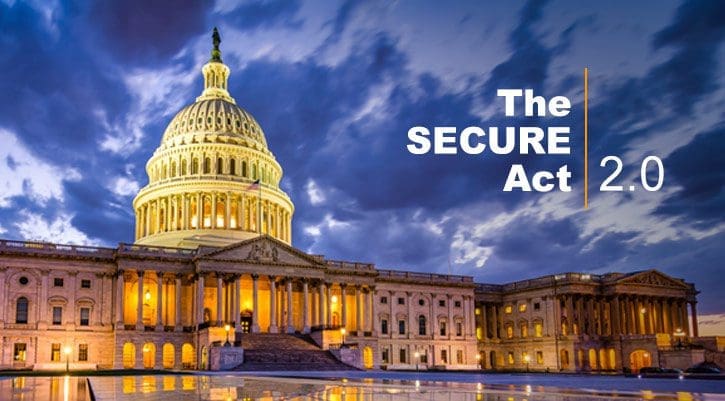In December 2019, the Setting Every Community Up for Retirement Enhancement (SECURE) Act marked a pivotal moment in retirement planning, introducing substantial revisions to beneficiary distribution rules. However, its impact was swiftly eclipsed by the onset of a global pandemic, diverting attention from its provisions. Now, with the nation gradually shifting focus beyond the pandemic’s immediate concerns, it’s timely to revisit the SECURE Act and its recent amendment, the SECURE Act 2.0, which came into effect this year. This article offers an insightful overview of these legislative measures, highlighting their significance in the evolving landscape of retirement planning.

Secure Act 2.0 increased the Required Minimum Distribution (“RMD”) age
Both the Secure Act and the Secure Act 2.0 increased the Required Minimum Distribution (“RMD”) age. Now Retirement Account owners are not required to take any funds from their retirement account, which distributions are income taxable, until later ages.
This year, the RMD age is 73 and it is scheduled to increase to 75 in 2033. That may seem like a good tax avoidance change; however, in the long run, the changes enacted by the Secure Act could cost your family more in income taxes.
Related Post: When To Apply For Social Security Retirement Benefits By Age
Most non-spouse beneficiaries are now subject to a 10-year distribution rule
One of the most notable changes brought by the Secure Act was the alteration of the rules governing retirement accounts left to beneficiaries, including the impact on children who inherit these accounts.
The legislation introduced several key provisions that will profoundly affect the way inherited retirement accounts are managed, particularly for non-spouse beneficiaries like children.
Before the SECURE Act, non-spouse beneficiaries, such as children, had the option to stretch out the distribution of inherited retirement accounts over their life expectancy. This allowed for tax-deferred growth and minimized the immediate tax burden on the inherited funds.
However, the SECURE Act made substantial changes to this distribution strategy. Under the new law, most non-spouse beneficiaries are now subject to a 10-year distribution rule.
Related Post: Asset Protection Planning Benefits For Medicaid
The 10-year distribution rule mandates that beneficiaries must withdraw all funds from inherited retirement accounts by December 31, ten years after the account owner’s death. This change has significant implications for children inheriting retirement accounts.
This means that beneficiaries can no longer stretch out distributions over their lifetime, potentially leading to larger taxable distributions over a shorter period, especially since life expectancies generally mean that a parent passes when an adult child is toward the end of their career, presumably at their highest earning years.
One of the key concerns for children who inherit retirement accounts under the SECURE Act is the potential tax impact. With the 10-year distribution rule, beneficiaries may face higher tax bills since they must withdraw the entire account balance within a decade.
For large retirement account balances, this could result in substantial taxable income, potentially pushing beneficiaries into higher tax brackets. It’s essential for beneficiaries to carefully plan their withdrawals to minimize tax consequences.
Retirement account owners may also want to consider withdrawing more than their Required Minimum Distribution if their tax bracket is lower than their children, because in the long run the family overall will pay less in taxes.
Related Post: How To Avoid Capital Gains The RIGHT Way
SECURE Act eliminated the “stretch IRA” strategy
Additionally, the SECURE Act eliminated the “stretch IRA” strategy, which allowed beneficiaries to benefit from the tax-deferred growth of the inherited account over their lifetime. This means that children who inherit retirement accounts no longer have the option to extend the tax advantages of the account for decades, which was a significant planning advantage in the past.
To adapt to these changes, beneficiaries, including children, may need to reconsider their financial and estate plans. They may want to consult with financial advisors, tax professionals, or estate planning attorneys to explore alternative strategies for managing inherited retirement accounts.
It’s worth noting that some exceptions exist to the 10-year rule. Eligible designated beneficiaries, such as surviving spouses, disabled individuals, and minor children of the account owner, may still be able to take advantage of the old stretch distribution rules. However, even in these cases, it’s crucial to understand the specific requirements and plan accordingly.
In conclusion, the SECURE Act has brought significant changes to the distribution rules for inherited retirement accounts, affecting owners of retirement accounts and the beneficiaries who inherit them. The 10-year distribution rule and the elimination of the stretch IRA strategy have raised important tax and estate planning considerations for beneficiaries.
Related Post: Is Retirement Income Taxed In Connecticut?
Owners of retirement accounts and beneficiaries expecting to inherit retirement accounts should carefully evaluate their options, consider tax-efficient strategies, and seek professional guidance to make informed decisions that align with their financial goals and circumstances. While the new rules pose challenges, proactive planning can help mitigate the potential tax consequences and ensure the effective management of inherited retirement assets.
Disclaimer: The information provided in this article does not, and is not intended to, constitute legal advice and is for general informational purposes only.
Let Us Know How We Can Help!
Please fill in your contact information and a brief message about what you need help with. A consultation will need to be scheduled in order to provide legal guidance.
Joan Reed Wilson Esq. – Managing Partner
Practices in the areas of estate planning, elder law, Medicaid planning, conservatorships, probate and trust administration, and real estate. Admitted to practice in the States of Connecticut and California, she is the former President of the CT Chapter of the National Academy of Elder Law Attorneys (NAELA), an active member of the Elder Law Section of the Connecticut Bar Association, accredited with the PLAN of CT for Pooled Trusts, with the Veteran’s Administration to assist clients with obtaining Aid & Attendance benefits for long-term care needs and with the Agency on Aging’s CareLink Network.







